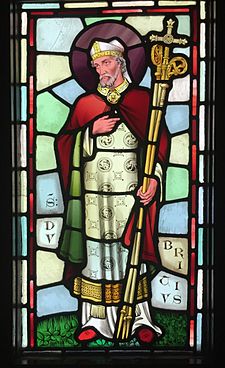Dubricius facts for kids
Quick facts for kids Saint Dubricius |
|
|---|---|

|
|
| Archbishop | |
| Born | 465(?) Madley, near Hereford, Herefordshire, England |
| Died | 550 Bardsey Island, Wales |
| Venerated in | Eastern Orthodox Church Roman Catholic Church Anglican Communion |
| Feast | 14 November |
| Attributes | holding two crosiers and an archiepiscopal cross |
Saint Dubricius (also known as Dubric or Dyfrig in Welsh) was an important religious leader from the 6th century. He is honored as a saint in several Christian churches. Dubricius helped spread Christianity in a region called Ergyng (now Archenfield in Herefordshire) and in much of south-east Wales.
Contents
Who Was Saint Dubricius?
Early Life and Family
Dubricius was born in a village called Madley in Herefordshire, England. His mother, Efrddyl, was the daughter of King Peibio Clafrog of Ergyng. When King Peibio found out about Efrddyl's pregnancy, he tried to drown her in the River Wye, but she survived.
After Dubricius was born, a special event happened. The baby Dubricius touched his grandfather, King Peibio, and cured him of his leprosy, a serious skin disease. This miracle helped Dubricius and his mother make peace with the king.
Becoming a Scholar and Teacher
From a young age, Dubricius was known for being very smart. As he grew up, he became famous across Britain as a great scholar. He started two important religious communities, called monasteries, in Hentland and Moccas.
Dubricius became a teacher to many well-known Welsh saints, including Teilo and Samson. He was also known for healing sick people by laying his hands on them. Some churches dedicated to him in Somerset suggest he might have traveled there too.
His Role as a Bishop
Later in his life, Dubricius became the Bishop of Ergyng. His main church might have been in Weston under Penyard. He probably had religious authority over a large area that later became known as the diocese of Llandaff. However, some believe he might have mainly been a bishop who could ordain priests, rather than the main leader of a large church area.
Dubricius was good friends with Saints Illtud and Samson. He also attended an important meeting called the Synod of Llanddewi Brefi in 545. At this meeting, it is said that he gave up his position as bishop to Saint David.
Later Years and Burial
After stepping down, Dubricius went to live a quiet life on Bardsey Island. He was buried there when he died. Many years later, in 1120, his body was moved to Llandaff Cathedral.
Legends About Dubricius
Crowning King Arthur
According to old stories and legends, Dubricius played a very important role. It is said that Saint Germanus of Auxerre made him the Archbishop of Llandaff. Even more famously, some legends claim that Dubricius was the one who crowned the legendary King Arthur.
Dubricius in Literature
Dubricius appears as a character in several famous old books. He is mentioned in Geoffrey of Monmouth's Historia Regum Britanniae and Wace's Roman de Brut, which were early stories about British kings. Much later, the famous poet Alfred, Lord Tennyson also included Saint Dubricius in his collection of poems called Idylls of the King.
Churches and Honor
Churches Dedicated to Saint Dubricius
Many churches are named after Saint Dubricius. In the Church of England, you can find churches dedicated to him in Ballingham, Whitchurch, Hentland, and Hamnish, all in Herefordshire. There is also one in Porlock in Somerset.
In the Church in Wales, churches are named after him in Gwenddwr in Breconshire and at Llanvaches in Newport. The Catholic Church in Treforest is also dedicated to Dyfrig.
When He is Honored
In the 2004 edition of the Roman Martyrology, which is a list of saints honored by the Catholic Church, Dyfrig is listed under November 14th. He is called Dubricius in Latin. It mentions that he died on Bardsey Island, which is off the north coast of Wales, as a bishop and abbot (a leader of a monastery). In the current Roman Catholic calendar for Wales, he is still remembered on November 14th.
How He is Shown in Art
When you see pictures or statues of Saint Dubricius, he is often shown holding two crosiers. A crosier is a special staff carried by bishops. Holding two crosiers shows that he had authority over two important church areas: Caerleon and Llandaff.

